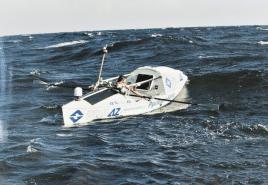John Hanke. John Hanke from [email protected] about geolocation services, Ingress, Field Trip and wearable computers
John Hanke is the man who made the whole world catch Pokémon

Pokemon Go creator John Hanke / Toru Hanai
Since July 6, when Pokemon Go became available in the US, Australia and New Zealand, the capitalization of the Japanese video game manufacturer Nintendo has more than doubled. But it should be noted that Nintendo did not participate in the creation of Pokemon Go and does not own the rights to the game, writes FT. The company has only a third in the Pokemon Company, which owns the rights to the Pokemon brand, and the same number in Niantic, the American startup that developed the game. Nintendo itself is engaged in consoles, and uses partners to break into the world of smartphone games. For example, Japan's DeNA is currently developing five games for it.
Pokemon Go is the brainchild of American John Hanke. He is called the founder of the MMORPG (Massively Multiplayer Online Role-Playing Game) genre, Google Earth and Google Maps originated from him, and now the world is going crazy over Pokémon.
Start
Hanke was born in the town of Cross Plains, lost among the cotton fields of Texas. The entire population is about 1000 people. The town is known for the fact that the writer Robert Howard grew up there. When he came to work at Google, Hanke hung a poster of Howard's most famous character, Conan the Barbarian, over his desk.
Hanke mastered programming himself while still in junior high school (grades 6-8). After graduating from the University of Texas at Austin in 1989, Hanke got a job at the State Department and managed to work in Washington and Myanmar (Burma). The turning point in his life was the decision to enter the business school. Walter Haas at the University of California. He graduated from school in 1996, but back in 1994, he and his MBA classmate Steve Sellers founded a startup Archetype Interactive in the business incubator of the university and started making an Internet game. It went down in history under the name Meridian 59 and is considered the first MMORPG in which people could play over the Internet, rather than a private network. This is significant because at the time, providers were using online games to compete for customers. For example, Neverwinter Nights was only accessible when a modem was connected to the AOL network.
Discovery of the earth
A test version of the Meridian 59 was released online in December 1995. The game used 3D graphics, just like modern online role-playing games. In the prehistory, it was said about an empire in which there were portals for the colonization of other worlds. Then the state broke up into a metropolis and colonies, chaos ensued, a war for power began, monsters appeared - in general, the players had something to do.
The game proved to be popular and in June 1996 it was sold to 3DO. Hanke worked on the project for two more years, and in 1998 he started a new, simpler project of his own. The Big Network startup was engaged in the creation of checkers and other casual games - that is, games with simple rules for a wide range of users.
A year later, Hanke sold it too and abandoned the idea of \u200b\u200bcreating games. At that time, he met a team of programmers who decided to make their own game and founded the startup Intrinsic Graphics. Previously, these guys worked for Silicon Graphics, a software and hardware developer for computer graphics. On the equipment of this company were made, for example, "Forrest Gump" and "Jurassic Park". They proudly showed Hanke their design, which allows them to play graphics with excellent quality on a regular computer. In the demo video, the camera looked from space at the Earth, and then ran into the surface, allowing you to see individual streets, is described in the book by Jerome Angel "World clusters of innovations".
Hanke was amazed. But by no means what the startups hoped for. At that time, space images of the surface of our planet had just begun to go on public sale. Hanke tried to convince them and their investor to forget about developing a new game and go into cartography, but to no avail. Then he bought out the technology that calculates the increase in scale, hired programmers - and thus the Keyhole startup was born. It was January 2000, a bright future was predicted for dot-com companies, and Hanke easily got funding from Sony. “Our goal is simple - to put the whole world at the disposal of our customers,” Hanke wrote in a 2001 press release. Three-dimensional images have appeared in the maps of his Earth Viewer software. But by no means all parts of the Earth, but only those for which satellite images and aerial photography were purchased. The picture was tied to geographic coordinates, various data were indicated on it: borders of regions and states, addresses and phone numbers of local companies, etc.
The project was actively growing - but then the dot-com bubble burst. The question of survival arose. The war in Iraq did not help. Funding poured into Keyhole even before the bombs began to fall, The Mercury News reported. The money came from the developer of graphics accelerators and processors NVIDIA and the venture capital fund In-Q-Tel, which invests in developments that can be used by intelligence services. Hanke's maps turned out to be interesting not only for the CIA. Earth Viewer happily used CNN, ABC, CBS and other TV channels to illustrate stories about the Gulf War.
The TV picture caught the attention of investors. In 2004, Keyhole was ready to close the B funding round. But a few days earlier, Hanke received a call from Google. At that time, the brainchild of Sergei Brin and Larry Page was a noticeable company, but not such a monster as it is now. Google has not sought to reveal its financial capabilities, has not yet held a high-profile IPO, has not taken over the market for software for smartphones. A manager from Google's business development division asked Hanke to give a presentation, especially since their offices were located nearby. Less than 24 hours after the meeting, Keyhole received a $ 35 million offer from Google and canceled the funding round.
Under the shadow of Google
Google resources have played a vital role in the development of the project. In 2002, an annual subscription to Earth Viewer cost $ 1200. As soon as the need for money disappeared, the price was lowered to $ 30, and when in June 2005 the project was released under the name Google Earth, it was free. In the book “Global Clusters of Innovation,” an example is given: Hanke asked Brin for permission to purchase some of the satellite imagery for sale. Bryn ordered to buy everything that comes across.
At Google Hanke, he served as vice president of product development for the Geo division. He developed one interesting project after another: Google Earth, Google Maps, Local, Street View, SketchUp (a program for modeling simple three-dimensional objects, bought by Google in 2006), Panoramio (a photo service with geographic coordinates). Under the leadership of Hanke, there were more than one hundred employees, but there was no former freedom. In 2010, he decided to give up everything and start his own business again. But Google didn't want to let go of the valuable employee. The parties agreed that Hanke will launch his startup inside Google.
The new project was dubbed Niantic Labs (see sidebar). The first project was the Field Trip mobile application. It keeps track of where the user is going, and tells him interesting events from history that took place on this street, advises him to take a detour and look at this or that landmark - and on the way go to a restaurant or store.
The next brainchild of Niantic was the game Ingress, built on the principle of augmented reality. You turn on the video camera on the gadget and look at the image on the screen. But the program draws fictional objects to real landscapes and objects.
“I have a feeling that we are present at the birth of a new genre<...> as is the case with Flight Simulator and Doom, ”Hanke quoted The Independent as saying. Ingress was not the first augmented reality game, but Flight Simulator and Doom were not pioneers either, but in many ways they laid the laws of the genre.
Ingress has two factions - "Enlightened" and "Resistance". The first help some mysterious mind - shapers - to penetrate into our world. Supposedly they will bring with them a new era of enlightenment. The Resistance believes the Shapers' goal is to enslave humans. Both factions are fighting, conquering portals. The difference from ordinary computer games is that portals are real objects. As a rule, cultural - from historical monuments to graffiti on the wall.
The game's biggest challenge was getting the player to get to the first portal. “Many people downloaded the game, not realizing that in it you need to get to different places. [People asked] where are the control buttons? How do you make the character move? " - Hanke told The Independent. Then it dawned on them that they had to turn on the GPS and move themselves so that your character began to move. True, this was not without a scam. Programs have been written that tell the game the wrong GPS coordinates. With their help, it was possible to travel around the city without leaving the apartment, like on Google Earth. But if the deception was revealed, the lazy person was banned.
When he got to the place, the player looked through the smartphone's camera, and the program drew the image of the portal to the picture. Then the player made a note in the smartphone about his capture. The capture rules were different, sometimes it was necessary to unite in groups for this.
Resource Pocket Gamer claims that one advanced Ingress gamer covered 100,000 miles (about 161,000 km) while playing in the real world. There was a case when a gamer was hired a private jet so that he could get to a remote portal and connect it with a portal in his hometown - his fellow gamers chipped in on the flight (“Even I was amazed,” admits Hanke). Hanke shared stories of climbing the mountain to get to the portal, and getting to know each other and getting married through the game. As with Pokemon Go, this was one of the goals: to take people from behind home computers to the streets and to push people into communication in the real world.
Ingress was launched in beta in November 2012. In early 2013, Hanke realized that players were assigning diversions - coming together in the real world. They had an idea to make these meetings part of the game, writes The Independent. In February 2013, such a gathering, formalized as a mission in the game, was assigned to the Cahokia Historic Site, a group of 109 North American Indian mounds in Illinois. As luck would have it, the day turned out to be cold and rainy, and it was not very close to the mounds from the city. The creators of the game decided that the meeting had failed. Imagine their surprise when about 60 people spent almost the whole day running between the mounds and playing Ingress. Over time, such events began to gather crowds of thousands, not only in the United States, but also in Japan and Spain.
Ingress players were given the opportunity to propose portals themselves. The main criterion was that it had to be a crowded, remarkable or beautiful place. Hanke did not take into account one thing - in the first two years alone, the game was downloaded 8 million times. So his team received about 15 million applications for portal sites. “We have approved about 5 million of them worldwide,” Hanke told Mashable. Last year, Niantic employed 41 people, they were physically unable to cope with the flow of proposals and removed the opportunity to make an application from the game. But the network of portals and statistics of player movements played an extremely important role in another project - based on this information, the next game, Pokemon Go, was built.
Pokémon are coming
Pokemon Go was born out of a joke. In 2014, on April 1, April Fools' Day, Google and the Pokemon Company teamed up, hid Pokemon in different places on the mobile version of Google Maps and invited users to find them. The success of the action made Hanke think. The Pokemon rights are owned by The Pokemon Company, a joint venture equally owned by Pokemon game developer Game Freak, toy maker Creatures, and Nintendo. Hanke went to negotiate with The Pokemon Company CEO Tsunekatsu Ishihara about a new game with his animals and augmented reality, and it was unexpectedly revealed that Ishihara and his wife are passionate Ingress players. Their heroes are more pumped than the character of Hanke himself. This greatly facilitated the negotiations.

Why Hanke named his startup Niantic Labs
Hanke chose a name for the startup that would show that there are many interesting things hidden around us, says The Mercury News. Niantic is the name of a whaling schooner launched in 1832. In 1849, she was unlucky enough to sail to California in the midst of the gold rush. Almost the entire crew fled from the ship to the gold mines. It was not possible to find new sailors, so the ship was dragged ashore and converted into a hotel. It was a common practice then. The hotel burned several times, then it was rebuilt again, the cultural layer increased - and over time, the ship literally grew into the street. His remains were stumbled upon in 1978 while digging a pit next to the 260-meter Transamerica skyscraper in San Francisco.
In 2015, there was another important event for the developer. Google has conceived a reorganization of its business into the Alphabet holding, which ended in October last year. The various directions were split into separate companies. Google previously developed services like Google Maps as a horizontal, low-level platform, Hanke complained to Business Insider. In other words, Niantic had no right to collaborate with other developers if their joint product used Google's developments. Now he was free.
In November 2015, Niantic held a Series A funding round, raising $ 20 million from the Pokemon Company Group, Google and Nintendo. “We haven't gone far from the nest. We're just five minutes away, ”Hanke told VentureBeat. “But it’s very important for us that we are outside the Google mother ship. This is our universe "
In February of this year, Niantic received another $ 5 million in investment from Fuji Television Corporation's venture capital fund and Alsop Louie Fund. Not only money was important, but also knowledge. The Japanese broadcaster is good at Asian marketing. And Alsop Louie founder Louis Gilman is a branding specialist, explained to Hanke on the Niantic blog. He knows Gilman firsthand - he was the co-founder and the first CEO of the In-Q-Tel fund to invest in Keyhole.
But working with Gilman paved the way for conspiracy theorists. In-Q-Tel works for the CIA, they grumble. Thanks to Google Maps, American intelligence filmed our streets, but could not look inside the buildings. Games like Ingress and Pokemon Go solved this problem. Now it is enough to send a rare Pokemon to the desired room - and the online broadcast is ready.
Three Pokemon Challenges
In addition to the commercial game, Pokemon Go has three important tasks, writes Business Insider.
The first is physical training. A variety of fitness apps leave an aftertaste like you're an athlete who screwed up at the Olympics, Hanke sneers. Pokemon Go does not insist that you have to run so many kilometers or burn so many calories, otherwise you will lose. On the contrary, the game offers a tasty prize, a Pokemon, if you still gather your strength. The game has such a quest: find an egg and walk a certain distance with it. Then a Pokemon will hatch out of it.
The second is to look at the world with a new look. Many points in the game are tied to historical or just beautiful places, so even your hometown can be rediscovered.
Finally, the game sets people up to communicate. In pursuit of Pokémon or in the stadiums where they are trained, people meet in the real world. And at a certain stage, according to the terms of the game, they are simply forced to unite in order to win.
The game itself consists of several parts. First, you look for and catch Pokémon. To do this, you need to throw a virtual ball at them. Pokemon can be everywhere, one was recently found on the desktop of a Vedomosti employee. But most of them are in places where players congregate (for example, near the Yandex office) and near the so-called Pokestops. These are points where players can replenish their supply of balls and find other useful virtual items. After a certain level, players can put their Pokémon on fights on special sites, and then fight the team against the team. The locations of these actions were determined precisely thanks to the Ingress portals. “For two and a half years, people have been visiting places where, in their opinion, it is more convenient to play Ingress, so there are quite remote locations among them. There are portals in Antarctica and at the North Pole, ”Hanke stated in an interview with Lazygamer.net.
But mixing the game with the real world also creates some difficulties, Hanke admits in The Time: “Our instructions for players are not only about how to play, but also the need to comply with the law and respect private property, and communicate politely with other users. The latter we try to inspire our users in all ways. The design of the product itself is specifically tailored for this. This is not a game about how to beat someone. The gameplay (scenario of a computer game - Vedomosti) is friendly and, I think, promotes positive social interaction. "
Overwhelming interest
“We counted on success and prepared the infrastructure for this. But, to be honest, they were slightly overwhelmed by the scale of interest, - Hanke told The Time. "We are now trying to maintain the infrastructure so that it can cope with the influx of people who want to play." A Russian gamer complained to Vedomosti that as soon as morning comes in the US, there are problems with access to the game server.
Pokemon Go is a free game, but for money, users can make their lives easier by purchasing services and artifacts, for example, to speed up the leveling of monsters. A similar strategy was used by King Digital, which released the hit for smartphones Candy Crush in 2012, writes FT. In 2013, she admitted that 96% of users did not pay a cent. True, the remaining 4% allowed to show such financial results that in 2015 King Digital was sold to Activision Blizzard, the manufacturer of World of Warcraft, for $ 5.9 billion.
In both Ingress and Pokemon Go, for a certain amount, any company can make their store or office a place for a portal and the appearance of rare Pokemon. Ingress's partners are McDonald’s, telecommunications and media corporation SoftBank, and Mitsubishi UFJ Financial Group. When Pokémon appear in Russia, this list, apparently, will include domestic companies.
John Hanke
John Hanke is the founder and CEO of Keyhole, Inc. , which was acquired by Google in 2004 and whose flagship product was renamed to Google Earth. Hanke is currently the director of Google Earth & Google Maps.
Hanke received his bachelor "s degree (Plan II Honors) from the University of Texas, Austin and his MBA from the Haas School of Business at the University of California, Berkeley in 1996. Prior to business school, he worked in" foreign affairs " , according to his bio, for an unspecified branch of the US Government in Washington, DC, Myanmar and Indonesia. Upon Graduation, he subsequently helped start two successful entertainment software companies, Archetype Interactive and Big Network.
External links
* [ http://www.keyhole.com/body.php?h\u003dabout Keyhole, Inc Company Information ]
Wikimedia Foundation. 2010.
Look at other dictionaries:
John Cranko - John Cyril Cranko (* 15 August 1927 in Rustenburg, Südafrika; † 26. Juni 1973 auf einem Rückflug aus den USA) war ein britischer Tanzregisseur und Choreograf. Grabstein auf dem Solitude Friedhof Cranko studierte zuerst in Kapstadt. 1946 ging e… Deutsch Wikipedia
John - m English form of Latin Johannes, New Testament Greek Iōannēs, a contracted form of the Hebrew name Johanan ‘God is gracious’ (the name of several different characters in the Old Testament, including one of King David s ‘mighty men’). John is the… First names dictionary
This page lists notable alumni and students of the University of California, Berkeley. Alumni who also served as faculty are listed in bold font, with degree and year. Notable faculty members are in the article List of UC Berkeley faculty.Nobel…… Wikipedia
Seal of the University of California, Berkeley Motto Latin: Fiat Lux Motto in English Let There Be Light… Wikipedia
Infobox Scientist name \u003d Alberto Conti box width \u003d image width \u003d caption \u003d Alberto Conti playing statue in France birth date \u003d birth date and age | 1966 | 09 | 27 birth place \u003d Palmanova, Italy death date \u003d death place \u003d residence \u003d (1966 ndash ; 1994) ... ... Wikipedia
Infobox University name \u003d The Haas School of Business motto \u003d Leading Through Innovation established \u003d 1898 type \u003d Public dean \u003d Richard Lyons city \u003d Berkeley state \u003d California country \u003d USA website \u003d)






